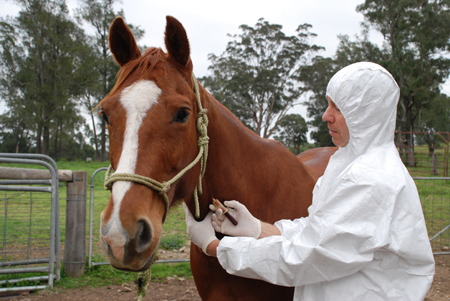The management of influenza outbreaks in horses will directly benefit from research by the Faculty of Veterinary Science at the University of Sydney.
“We have demonstrated in non-laboratory conditions how air temperature, humidity and wind velocity influence the spread of influenza viruses. It puts us in a much better position to understand an actual outbreak of influenza in horse populations, under natural conditions,” said Dr Navneet Dhand, the principal investigator of the research project.
The team analysed data from the 2007 equine influenza or ‘horse flu’ outbreak in Australia together with data provided by the Australian Bureau of Meteorology for the same time period.
The researchers discovered horses were more likely to get infected on days when relative humidity was low and less likely to get infected on days when the maximum daily air temperature was between 20 and 25°C.
The findings were published in PloS One, the Public Library of Science, on 21 April.
“The results will be invaluable in modelling the spread of influenza viruses in the unique Australian environment and landscape,” said Simon Firestone, the lead author of the paper and a PhD candidate at the University of Sydney’s Faculty of Veterinary Science.
Notably, horses on premises downwind of those on nearby infected premises were more likely to become infected. The risk was higher on days when wind speeds were greater than 30 kilometres per hour, substantiating numerous anecdotal reports of the windborne spread of equine influenza.
“This gives an important indication of how weather conditions can affect the spread of the equine influenza virus and therefore allow us to better predict the outcome of a future incident of the virus in Australia,” said Dr Dhand.
The equine influenza outbreak occurred in 2007 following a breach in the quarantine of infected imported horses. Nearly 70,000 horses on over 9000 premises in NSW and Queensland were infected at a cost of over $350 million. The disease was eradicated within five months, mainly due to the fast introduction of a complete ban on horses being moved.
“By having a better idea of how the disease spreads, our findings will help animal disease authorities reduce the cost of outbreak management as well as the social impacts of the outbreak,” Dr Dhand said.
Although the study results are only valid for equine influenza viruses, they could have implications for understanding the spread of influenza A viruses, providing opportunities for collaborations between veterinary and human public health scientists to better understand the transmission of influenza viruses.
The research was conducted by a team which also included Professor Michael Ward, Chair Veterinary Public Health, and Associate Professor Jenny-Ann Toribio, both from the University of Sydney, Dr Barbara Moloney from the NSW Department of Primary Industries and Dr Naomi Cogger from theMassey University’s Epicentre (New Zealand).
It was a part of a jointly funded project supported by the Rural Industries Research and Development Corporation’s Horse research program, and the Animal Biosecurity Cooperative Research Centre for Emerging Infectious Diseases.
A veterinarian collecting a blood sample from a horse for lab testing during the 2007 equine influenza outbreak in Australia. Photo from: NSW Department of Primary Industries.



